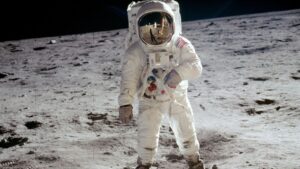This densely populated group of stars is the globular cluster NGC 1841, which is part of the Large Magellanic Cloud (LMC), a satellite galaxy of our Milky Way galaxy that lies about 162,000 light-years away. Satellite galaxies are bound by gravity in orbits around a more massive host galaxy. We typically think of the Andromeda Galaxy as our galaxy’s nearest galactic companion, but it is more accurate to say that Andromeda is the nearest galaxy that is not in orbit around the Milky Way galaxy. In fact, dozens of satellite…
Read MoreNASA’s Global Precipitation Measurement Mission: 10 years, 10 stories
An extra-tropical cyclone seen in the Pacific Ocean off the coast of Japan on March 10, 2014, by NASA’s GPM Microwave Imager. Credit: NASA From peering into hurricanes to tracking El Niño-related floods and droughts to aiding in disaster responses, the Global Precipitation Measurement (GPM) mission has had a busy decade in orbit. As the GPM mission team at NASA and the Japan Aerospace Exploration Agency (JAXA) commemorates its Feb. 27, 2014 launch, here are 10 highlights from the one of the world’s most advanced precipitation satellites. First Images Available…
Read MoreUpdate on Status of NASA’s OSAM-1 Project
1 min read Preparations for Next Moonwalk Simulations Underway (and Underwater) Following an in-depth, independent project review, NASA has decided to discontinue the On-orbit Servicing, Assembly, and Manufacturing 1 (OSAM-1) project due to continued technical, cost, and schedule challenges, and a broader community evolution away from refueling unprepared spacecraft, which has led to a lack of a committed partner. Following Congressional notification processes, project management plans to complete an orderly shutdown, including the disposition of sensitive hardware, pursuing potential partnerships or alternative hardware uses, and licensing of applicable technological developments.…
Read MoreIntroduction to STEM Learning Ecosystems: Video Series
2 min read Introduction to STEM Learning Ecosystems: Video Series STEM learning ecosystems are intentionally designed, community-wide partnerships that enable people to actively participate in Science, Technology, Engineering, and Mathematics (STEM) throughout their lifetimes. These partnerships draw on expertise and resources across a community to create equitable access for learners of all ages. To learn more about the concept and implementation of STEM learning ecosystems, educators, scientists, and other STEM engagement professionals are invited to view the new video series from the NASA Science Activation (SciAct) Program’s STEM Ecosystems project…
Read MoreNight-Shining Cloud Mission Ends; Yields High Science Results for NASA
5 min read Night-Shining Cloud Mission Ends; Yields High Science Results for NASA NASA’s Aeronomy of Ice in the Mesosphere (AIM) mission, seen in this visualization, contributed to NASA’s understanding of the region that borders between Earth’s atmosphere and space. NASA After 16 years studying Earth’s highest clouds for the benefit of humanity – polar mesospheric clouds – from its orbit some 350 miles above the ground, NASA’s Aeronomy of Ice in the Mesosphere, or AIM, mission has come to an end. Initially slated for a two-year mission, AIM was…
Read MoreOukitel BP2000 power station review
KEY SPECIFICATIONS Power: 2048WhCapacity: 640,000 mAhOutput ports: 15 (5x AC, 4x USB-A (2x 12W, 2x 18W), 2x USB-C PD 100W, 1x car 12V/10A, 1x 24V/10 AV, 2x 12V/3A DC5521)Charging time: 80% charge in 53 mins using ACIP rating: NoneWeight: 50.7 lbs (23 kg)Dimensions: 480 x 296 x 322 mm We’ve reviewed several of the best power stations over the past few years, and we frequently receive requests from brands to review their products. The Outkitel BP2000 (aka FF power BP2000) caught our attention for a specific reason, which might sound…
Read MoreNASA Selects ACMI as Second Approved Exploration Park Facility
NASA NASA and the American Center for Manufacturing and Innovation (ACMI) signed an agreement Thursday, Feb. 29 to lease underutilized land in a 240-acre Exploration Park at the agency’s Johnson Space Center in Houston. ACMI will enable the development of facilities to enable commercial and defense space manufacturing. The agreement is the second such public/private lease agreement to allow industry and academia to use NASA Johnson land to create facilities for a collaborative development environment that increases commercial access and enhances the United States’ commercial competitiveness in the space and…
Read MoreChina names the spacecraft that will put its astronauts on the moon (video)
China’s human spaceflight agency has given names to spacecraft being developed to put astronauts on the moon. Mengzhou is the name for the spacecraft that will take astronauts beyond low Earth orbit, while the lunar lander has been named Lanyue. Lanyue means “Embracing the Moon,” referencing the Tang dynasty poet Li Bai. China’s human spaceflight Agency, CMSA, said in a press statement that the chosen name appears in a Mao Zedong poem. Mengzhou, meanwhile, means “Dream Vessel” and fits into the naming style for China’s Shenzhou and Tianzhou spacecraft, which…
Read MoreLangley Celebrates Black History Month: Clayton Turner
4 min read Preparations for Next Moonwalk Simulations Underway (and Underwater) Clayton P. Turner serves as the Director of NASA’s Langley Research Center in Hampton, Virginia. His career at NASA Langley has spanned 33 years. Clayton P. Turner serves as the Director of NASA’s Langley Research Center in Hampton, Virginia. His career at NASA Langley has spanned 33 years. His experiences prior to his career with NASA include three years of military service. He graduated from Rochester Institute of Technology in Rochester, N.Y. with a bachelor’s degree in electrical engineering. …
Read MoreStudent Teams to Help Fill the Inflatable Void with Latest Student Challenge
3 Min Read Student Teams to Help Fill the Inflatable Void with Latest Student Challenge This year will be a “BIG” year for several college and university teams as they research, design, and demonstrate novel inflatable systems configured for future lunar operations through a NASA-sponsored engineering competition. NASA’s Breakthrough, Innovative and Game-Changing (BIG) Idea Challenge asked student innovators to propose novel inflatable component and system concepts that could benefit future Artemis missions to the Moon and beyond. The Inflatable Systems for Lunar Operations theme allowed teams to submit various…
Read More













